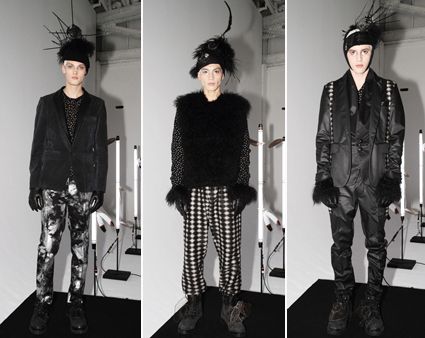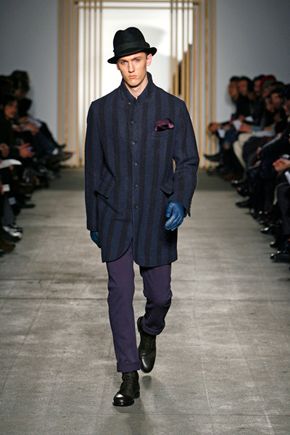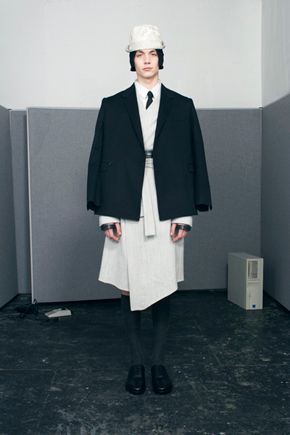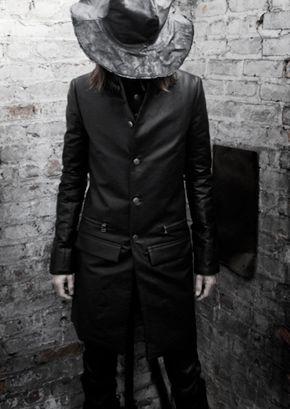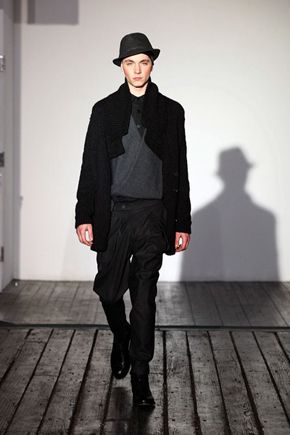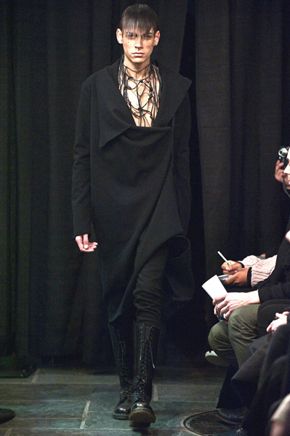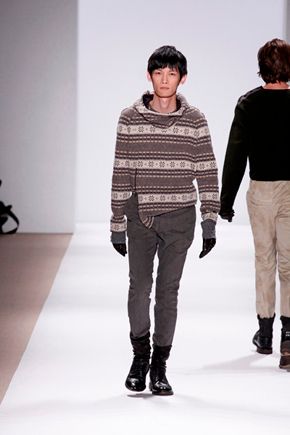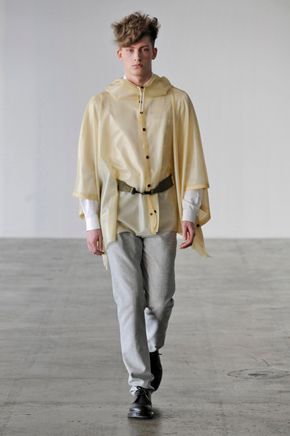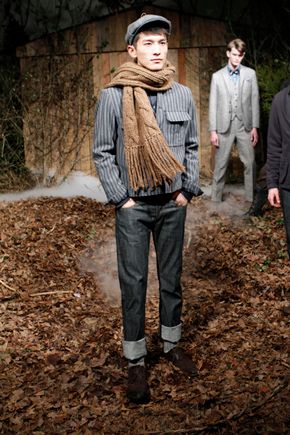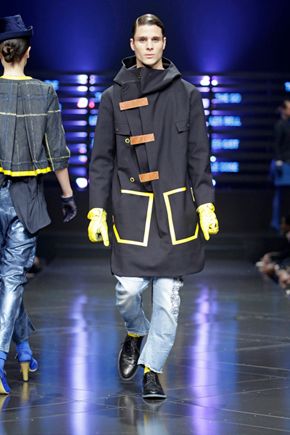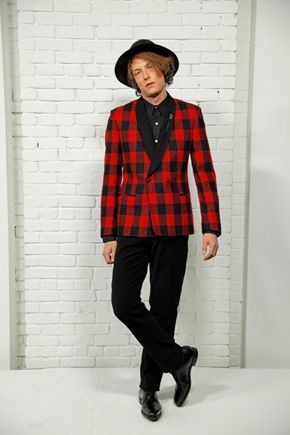

Damir Doma is a young Croatian-born menswear designer in the prime stages of his career. He grew up in Germany, studied fashion at Esmod in Munich and Berlin and is currently based in the fashion capital of Paris. Doma’s creations are unlike most options available to men today, and the 28-year-old Raf Simons protégé has already been compared to gothic greats like Rick Owens and Ann Demeulemeester. After his debut collection, Damir Doma quickly became a name to watch in the menswear industry– however fickle it may be. While greatly inspired by his natural surroundings, Doma is also a purveyor of art, and counts significant 20th century German artists Anselm Kiefer, Joseph Beuys and Gerhard Richter as important influences in his creative design process. A perfectionist who values originality in every dimension, Doma is known to even compose the music played during his own runway shows.

Doma’s Autumn/Winter 2009-2010 collection featured pale-faced models swathed in layers of beautifully draped fabric, heavy wool coats, leggings and asymmetrically cut jackets with rounded or sloping shoulders. An abundance of looks came in winter white, though Doma didn’t forget to include various shades of grey and his favorite, jet black. There were zip-front jumpsuits and boots, full trousers with tapered ankles, head wraps and lots of braided detailing.
The designer’s latest collection for Spring/Summer 2010 was shown at the Palais de Tokyo in Paris this June. His new looks expand upon the ideas and silhouettes formed in the previous season: oversized shapes, multi-layered fabrics and thought-out androgynous appeal. The collection has a much more natural pallet of earth tones, with neutral shades of beige, cream, and ivory– although the most surprising aspect this season is a multitude of eye-popping blood red pieces. With slicked-back hair and stern gazes, the models were outfitted in sheer tanks, oversized linen tunics and trousers, crisp white jackets and sheer harem shorts paired with sturdy boots or strappy Jesus sandals. Doma paid great detail to the varying textures and movement of the fabric, making the collection one of his strongest yet.
WANTED: How did you first become interested in fashion?
DAMIR DOMA: Fashion was all around me when I was growing up. My mother is a fashion designer as well. My sister and I were always playing with her fabrics, and at an early age we started to create our own things. My first contact with a well-known fashion designer was when I was about 14 or 15 years old. I grew up in a little city in the South of Germany, so it was quite hard to buy fashion clothes. There was and still is one tiny fashion boutique called “Altra Moda.” That’s the shop where I bought my first Helmut Lang pieces! I used to be a big fan of Helmut– I think it’s really sad that he stopped designing.
W: What was it like growing up in Germany?
DD: My childhood was really amazing. I was very lucky growing up in South Germany, just in front of the Alps-- between the lakes and the mountains. I spent most of my time outside, playing sports and exploring the nature.
W: What made you decide to start designing your own label?
DD: My personality is one that needs to create new things. I believe that it’s my destiny to create and it actually doesn’t matter so much if it is fashion or anything else. I need to merge myself into my work and I always wanted to create my own universe and to express myself.

W: Can you tell me what it was like to show your collection at Modniy Desant in St. Petersburg?
DD: Modniy Desant was an exiting experience for me and also for my whole team. It was my first time in Russia. As I’m originally coming from a Socialistic country, I had some kind of image in mind before entering Russia. At the border we immediately had the pleasure to meet the Russian custom officers. That was shocking. I remember I thought that we would never enter Russia with the full collection! Besides some initial difficulties, the trip was nice. We did a beautiful show and I met Frol [Burimskiy], who is now part of my team. He moved from St. Petersburg to Paris, and is the responsible for our Paris Damir Doma boutique.
W:W: What was the purpose behind your Viel video collaboration with Alessandro Tinelli?
DD: When it comes to art, most of the time the process is the purpose. I met Alessandro during my first visit to Tokyo in 2007. Alessandro is an Italian artist who moved to Japan a few years ago. Masahiro Tsunoda from Lift introduced us to each other. In the last two years we’ve done so many things together. Alessandro’s specialties are video, video post-production and music. Viel is the video/music form of Damir Doma. We tried to explain my universe through different “eyes.”
W: Your Identity project shows how influenced you are by nature– can you discuss how the great outdoors has shaped your character as well as your collections?DD: First of all, I believe that it’s crucial that my personality and my collection is 100% as “one.” As I mentioned earlier, I grew up with nature all around me, and I believe that a big part of my aesthetics developed in my early years. I love natural materials and colors– but my concept goes much further. I believe that clothing and body have to be a unity– clothing shouldn’t fight against the shape of the body. Clothing needs to respect the individual’s identity. A masquerade is not an option for me. I’m a very respectful, calm and sensitive person– and that’s what you'll find in my clothing. They are subtle and profound. My collections need to be explored and well understood.

W: What was it like to work for your mentor Raf Simons?
DD: Raf has a great personality. I remember that I was overwhelmed at the beginning. When I was at fashion school I looked up to him. Raf showed me a new perspective on fashion and a new way of working. At the end, it’s hard to recognize his influence on my work, as we don’t share the same aesthetics, but I adopted some of his concepts.
W: What other designers are you influenced or inspired by?
DD: As I mentioned at the beginning, I loved Helmut Lang and I also like Jil Sander. I adore the early work of Issey Miyake.
W: You also worked for Dirk Schoenberger– what was that experience like?
DD: Working with and for Dirk was more difficult for me, as we were never able to find a common denominator. At that time, Dirk was part of the BVBA 32 [a Belgian collective that produces high quality designer goods]. I believe that from a business point-of-view, I learned a lot during that period. I learned how to structure a good collection, and I learned to be focused.
W: You referenced the German painter/sculptor Anselm Kiefer as an inspiration behind your latest collection for A/W ’09-‘10– can you explain why?
DD: Anselm Kiefer did a fantastic exhibition in the Grand Palais two years ago. I love Kiefer’s images, haptics and structures. I imagined the models walking through the deserts of stone towers, which he built up. In his work, nature conquers the human creation, and I think that’s an amazing idea.
W: I got a bit of a post-apocalyptic Star Wars vibe from this collection– I could see Luke Skywalker wearing a lot of these looks– is that something you thought about?
DD: I’m not a big Star Wars fan, but I can see the connection. In particular, you are probably thinking of the priests in the movie. I like the idea of spirituality!
W: What are your favorite fabrics to work with?
DD: I work with all kinds of natural materials. It really depends on the product, but in general, linen is my favorite material. Linen has some kind of life of it’s own– you have to treat it with respect.

W: How do you pick the haunting music for your shows?
DD: For a while we have been composing the music especially for the shows. I decided this way works better for me, because I don’t want to give any references. The music goes hand in hand with the clothing, the materials and the colors. I’m a creator. The fashion show is giving an idea of the future and I believe that it’s wrong to use music that already exists.
W: You recently opened your flagship store in Paris – can you describe the experience?
DD: The store is our little baby. We take good care of it and we’re trying to raise it at the moment. We want it to be an amazing and cool adult!
W: What are your plans for the future of your label?
DD: We want to keep the label very exclusive. In the future we are planning to expand the Damir Doma universe with new products. I’m working on some very secret stuff right now. I also want to come up with a women’s line quite soon.
W: What are your other interests besides fashion?
DD: I love the arts. Every season I try to collaborate with a young artist to create other projects next to the collection.
Damir Doma’s designs are available in the U.S. at Atelier New York, Sartorial Loft and H. Lorenzo in Los Angeles, and Mixmix in Honolulu and Waikiki.
Written by Carolyn Brennan
Photo courtesy of Damir Doma and Etienne Tordoir











